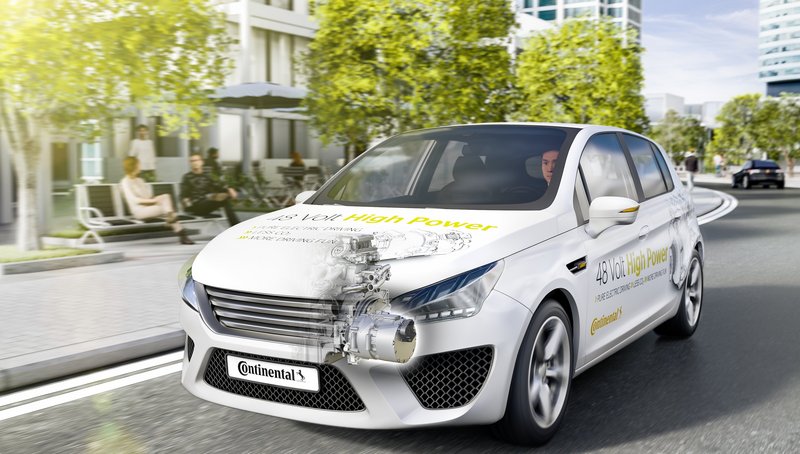Low Voltage, High Performance: Full-Hybrid Vehicle with 48-Volt High-Power Technology from Continental
- Electric-only driving in hybrid vehicles is enabled by 48-volt technology
- Same installation space, double the performance – innovative electric motor developed with up to 30 kW
- Advantages of the 48-volt high-power technology include compactness, efficiency and cost-effectiveness
Auburn Hills, Mich., August 5, 2019. The technology company Continental is excited to present the latest innovation to come from its 48-volt drive solution: the 48-volt high-power drive system with 30 kW. For years now, Continental has been backing environmentally friendly and cost-effective 48-volt electrification, which can be used with both gasoline and diesel engines. Up until now, a full-hybrid vehicle with 48-volt technology was deemed impossible.
For a hybrid vehicle to drive using just electricity, the electric part of the drive would normally use high voltage technology – high voltages of up to 800 volts. However, Continental has now succeeded in creating a 48-volt hybrid system that boasts features similar to those of a high-voltage electric drive.
“Our development objective was to achieve a level of driving efficiency with 48-volt technology that was previously reserved for high-voltage systems, and we have now done exactly that,” said Kregg Wiggins, senior vice president of Continental Powertrain, North America.
The new 48-volt high-power system, comprising an electric motor complete with integrated power electronics and a battery, reduces fuel consumption as well as CO2 emissions by around 20 percent compared with similar vehicles fitted with combustion-only engines. The new 48-volt technology is also more affordable than the high-voltage systems used up to now.
“Thanks to its broad systems expertise, Continental Powertrain is mastering all variants of the electric drive, from 48-volt systems to hybrid technologies, right through to high-voltage components. We offer expertise and state-of-the-art technology from a single source,” added Wiggins.
New stage of development: full hybrid without a complex, high-voltage system
The 48-volt systems were previously known as mild or P0 hybrids and involve relatively unobtrusive electrification of the powertrain. Fuel consumption is reduced mainly with the support of the combustion engine (boosting) during acceleration and the recovery of excess kinetic energy (recuperation) when the vehicle decelerates. However, purely electric driving is not possible with such systems, which Continental already manufactures for several automotive manufacturers. In the latest stage of development, the 48-volt system was repositioned in the powertrain. The electric motor is no longer placed in front of the combustion engine on the crankshaft, but behind it – between the combustion engine and transmission (P2 hybrid). This means that fuel savings were able to increase.
With the new 48-volt high-power technology, this hybrid system enables the same functionality as previous, full-hybrid vehicles. The key component here is a new, water-cooled electric motor, the peak output of which was doubled to 30 kW in comparison with that used previously. Electric-only driving is therefore possible up to a speed range of about 50 to 55 mph.
The developers were able to achieve a 100 percent increase in power while maintaining the diameter of the motor. Overall, 48-volt high-power technology requires only slightly more installation space than the previous system. The difference in weight is also minimal.
However, the electric motor is not the only new component of the 48-volt high-power technology. The integrated power electronics also uses a new technology that enables it to handle significantly higher currents. The innovations of the new 48-volt high-power technology result in a level of electrical efficiency that surpasses the previous system by almost 10 percent. During recuperation (the recovery of excess kinetic energy when the vehicle decelerates), the new technology is much more effective than before, cutting the losses incurred in the electric drive system in half.
New hybrid technology making the most of what is currently technologically possible
The 48-volt high-power technology provides all the benefits of a conventional, full-hybrid vehicle with a high-voltage system – significantly lower fuel consumption and CO2 emissions as well as optimized driving efficiency and drivability. There is also another argument in favor of the new hybrid solution from Continental, which is its relatively low costs. This is the key to making cheap hybrid vehicles available and achieving high market penetration. The 48-volt system requires considerably less effort in terms of insulation protection, its electrical components are smaller and cheaper, and even the design can be made significantly more compact, because smaller gaps are required between the individual components than is the case with high-voltage technology.
Full hybridization is made possible – all without the effort and costs involved in a high-voltage system.
Even a 48-volt plug-in hybrid drive would be possible
This 48-volt high-power technology could be developed even further. If, for instance, the system was supplemented by on-board charging technology and a larger battery, this would make even a plug-in hybrid drive featuring 48-volt technology possible. This is because the ability to drive in all-electric mode is no longer the main criterion for benefiting from the support for plug-in vehicles. Instead, it is the conversion of electrically stored energy into traction in general. The deciding factor for different funding initiatives is whether CO2 emissions can be reduced to below 80 g per mile (50 g / km).
Continental develops pioneering technologies and services for sustainable and connected mobility of people and their goods. Founded in 1871, the technology company offers safe, efficient, intelligent, and affordable solutions for vehicles, machines, traffic and transportation. In 2018, Continental generated sales of €44.4 billion and currently employs approximately 245,000 people in 60 countries and markets.
Powertrain develops and produces efficient system solutions for vehicle powertrains to optimize fuel consumption. The comprehensive range of products includes gasoline and diesel injection systems, engine management and transmission control, including sensors and actuators, exhaust aftertreatment technologies, fuel supply systems, and components and systems for hybrid and electric drives. Powertrain employs more than 42,000 people worldwide and, in 2018, recorded sales of around €7.7 billion.

Mary Arraf
Head of Communications Automotive and Continental North America

